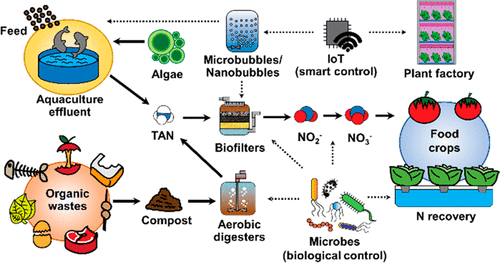当前位置:
X-MOL 学术
›
ACS ES&T Eng.
›
论文详情
Our official English website, www.x-mol.net, welcomes your
feedback! (Note: you will need to create a separate account there.)
Nitrogen Recovery via Aquaponics–Bioponics: Engineering Considerations and Perspectives
ACS ES&T Engineering ( IF 7.4 ) Pub Date : 2021-02-05 , DOI: 10.1021/acsestengg.0c00196 Sumeth Wongkiew 1 , Zhen Hu 2 , Jae Woo Lee 3 , Kartik Chandran 4 , Hua Thai Nhan 5 , Kyle Rafael Marcelino 6 , Samir Kumar Khanal 7
ACS ES&T Engineering ( IF 7.4 ) Pub Date : 2021-02-05 , DOI: 10.1021/acsestengg.0c00196 Sumeth Wongkiew 1 , Zhen Hu 2 , Jae Woo Lee 3 , Kartik Chandran 4 , Hua Thai Nhan 5 , Kyle Rafael Marcelino 6 , Samir Kumar Khanal 7
Affiliation

|
Nitrogen, a critically important nutrient that boosts yields in agriculture and food production, is currently overused to meet the rising demand for food. Surplus nitrogen ends up in the environment in excess of the capacity of natural nitrogen cycle, thereby leading to serious environmental pollutions, such as eutrophication of water bodies and emission of nitrous oxide (a highly potent greenhouse gas) to atmosphere. Aquaponics–bioponics is an emerging soilless technology for nitrogen recovery that links organic vegetable production to aquaculture effluent remediation (aquaponics) or organic waste recycling (bioponics). This Review presents the concept of aquaponics–bioponics for nitrogen recovery. Nitrogen transformations and nitrogen mass distributions in aquaponic–bioponic systems are critically discussed, along with the nutrient availability of several organic composts that can be integrated with the systems, and the microbial communities involved. This discussion is followed by a dynamic nitrogen modeling for managing nitrogen from different wastes in aquaponics–bioponics. Various emerging engineering technologies that could improve aquaponics–bioponics are presented, including aeration with microbubbles and/or nanobubbles, cocultivation with algae, process automation with Internet of Things, and integration with indoor vertical farming (plant factory with artificial light). Overall, the Review lays out the state-of-art in aquaponics–bioponics and highlights potential approaches for developing highly efficient nitrogen recovery technologies from diverse organic waste streams.
中文翻译:

通过水培法-生物培氮法进行氮回收:工程方面的考虑和观点
氮是一种至关重要的营养素,可提高农业和粮食生产的产量,目前已被过度使用,无法满足不断增长的粮食需求。过量的氮最终以超过自然氮循环能力的能力进入环境,从而导致严重的环境污染,例如水体富营养化和向大气排放一氧化二氮(强效温室气体)。鱼菜共生技术—生物共生技术是一种新兴的无土氮回收技术,可将有机蔬菜生产与水产养殖废水的修复(鱼菜共生)或有机废物循环利用(生物子学)联系起来。这篇综述提出了共生-生物共生用于氮回收的概念。讨论了水培-生物耕作系统中的氮转化和氮质量分布,以及可以与系统集成的几种有机堆肥的养分利用率以及所涉及的微生物群落。讨论之后是动态氮模型,用于管理鱼菜共生中不同废弃物中的氮。介绍了各种可以改善水培法-生物共生法的新兴工程技术,包括微泡和/或纳米泡的曝气,藻类的共培养,物联网的过程自动化以及与室内垂直农业(带有人工照明的植物工厂)的集成。总体而言,本综述阐述了鱼菜共生-生物共生的最新技术,并重点介绍了从多种有机废物流中开发高效氮回收技术的潜在方法。以及所涉及的微生物群落。讨论之后是动态氮模型,用于管理鱼菜共生中不同废弃物中的氮。介绍了各种可以改善水培法-生物共生法的新兴工程技术,包括微泡和/或纳米泡的曝气,藻类的共培养,物联网的过程自动化以及与室内垂直农业(带有人工照明的植物工厂)的集成。总体而言,本综述阐述了鱼菜共生-生物共生的最新技术,并重点介绍了从多种有机废物流中开发高效氮回收技术的潜在方法。以及所涉及的微生物群落。讨论之后是动态氮模型,用于管理鱼菜共生中不同废弃物中的氮。介绍了各种可以改善水培法-生物共生法的新兴工程技术,包括微泡和/或纳米泡的曝气,藻类的共培养,物联网的过程自动化以及与室内垂直农业(带有人工照明的植物工厂)的集成。总体而言,本综述阐述了鱼菜共生-生物共生的最新技术,并重点介绍了从多种有机废物流中开发高效氮回收技术的潜在方法。介绍了各种可以改善水培法-生物共生法的新兴工程技术,包括微泡和/或纳米泡的曝气,藻类的共培养,物联网的过程自动化以及与室内垂直农业(带有人工照明的植物工厂)的集成。总体而言,本综述阐述了鱼菜共生-生物共生的最新技术,并重点介绍了从多种有机废物流中开发高效氮回收技术的潜在方法。介绍了各种可以改善水培法-生物共生法的新兴工程技术,包括微气泡和/或纳米气泡的曝气,藻类的共培养,物联网的过程自动化以及与室内垂直农业(带有人工照明的植物工厂)的集成。总体而言,本综述阐述了鱼菜共生-生物共生的最新技术,并重点介绍了从多种有机废物流中开发高效氮回收技术的潜在方法。
更新日期:2021-03-12
中文翻译:

通过水培法-生物培氮法进行氮回收:工程方面的考虑和观点
氮是一种至关重要的营养素,可提高农业和粮食生产的产量,目前已被过度使用,无法满足不断增长的粮食需求。过量的氮最终以超过自然氮循环能力的能力进入环境,从而导致严重的环境污染,例如水体富营养化和向大气排放一氧化二氮(强效温室气体)。鱼菜共生技术—生物共生技术是一种新兴的无土氮回收技术,可将有机蔬菜生产与水产养殖废水的修复(鱼菜共生)或有机废物循环利用(生物子学)联系起来。这篇综述提出了共生-生物共生用于氮回收的概念。讨论了水培-生物耕作系统中的氮转化和氮质量分布,以及可以与系统集成的几种有机堆肥的养分利用率以及所涉及的微生物群落。讨论之后是动态氮模型,用于管理鱼菜共生中不同废弃物中的氮。介绍了各种可以改善水培法-生物共生法的新兴工程技术,包括微泡和/或纳米泡的曝气,藻类的共培养,物联网的过程自动化以及与室内垂直农业(带有人工照明的植物工厂)的集成。总体而言,本综述阐述了鱼菜共生-生物共生的最新技术,并重点介绍了从多种有机废物流中开发高效氮回收技术的潜在方法。以及所涉及的微生物群落。讨论之后是动态氮模型,用于管理鱼菜共生中不同废弃物中的氮。介绍了各种可以改善水培法-生物共生法的新兴工程技术,包括微泡和/或纳米泡的曝气,藻类的共培养,物联网的过程自动化以及与室内垂直农业(带有人工照明的植物工厂)的集成。总体而言,本综述阐述了鱼菜共生-生物共生的最新技术,并重点介绍了从多种有机废物流中开发高效氮回收技术的潜在方法。以及所涉及的微生物群落。讨论之后是动态氮模型,用于管理鱼菜共生中不同废弃物中的氮。介绍了各种可以改善水培法-生物共生法的新兴工程技术,包括微泡和/或纳米泡的曝气,藻类的共培养,物联网的过程自动化以及与室内垂直农业(带有人工照明的植物工厂)的集成。总体而言,本综述阐述了鱼菜共生-生物共生的最新技术,并重点介绍了从多种有机废物流中开发高效氮回收技术的潜在方法。介绍了各种可以改善水培法-生物共生法的新兴工程技术,包括微泡和/或纳米泡的曝气,藻类的共培养,物联网的过程自动化以及与室内垂直农业(带有人工照明的植物工厂)的集成。总体而言,本综述阐述了鱼菜共生-生物共生的最新技术,并重点介绍了从多种有机废物流中开发高效氮回收技术的潜在方法。介绍了各种可以改善水培法-生物共生法的新兴工程技术,包括微气泡和/或纳米气泡的曝气,藻类的共培养,物联网的过程自动化以及与室内垂直农业(带有人工照明的植物工厂)的集成。总体而言,本综述阐述了鱼菜共生-生物共生的最新技术,并重点介绍了从多种有机废物流中开发高效氮回收技术的潜在方法。









































 京公网安备 11010802027423号
京公网安备 11010802027423号